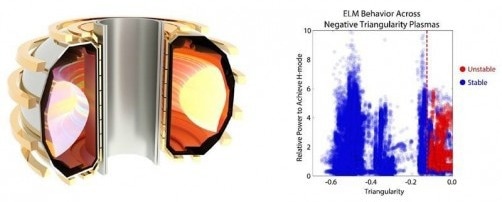Reviewed by Lexie CornerMar 12 2024
Fusion power plants need to produce and maintain the plasma conditions required to be economically feasible for fusion reactions. That being said, gradients in the temperature and density of plasmas frequently form at high temperatures and densities. These gradients could transform into edge localized modes (ELMs), which are examples of instabilities.
 Negative triangularity shaping in the DIII-D tokamak (left) produced plasmas with no observed instabilities for triangularities less than approximately -0.15, even at high heating power and core performance (right). Image courtesy of A.O. Nelson et al., Robust Avoidance of Edge-Localized Modes alongside Gradient Formation in the Negative Triangularity Tokamak Edge. Physical Review Letters 131, 195101 (2023)
Negative triangularity shaping in the DIII-D tokamak (left) produced plasmas with no observed instabilities for triangularities less than approximately -0.15, even at high heating power and core performance (right). Image courtesy of A.O. Nelson et al., Robust Avoidance of Edge-Localized Modes alongside Gradient Formation in the Negative Triangularity Tokamak Edge. Physical Review Letters 131, 195101 (2023)
The adjacent reactor wall could suffer damage from ELMs found in the plasma edge. The cross-sectional shape of the plasma can be a factor in ELMs.
Researchers use the word plasma triangularity to indicate how much the plasma form deviates from an oval shape. Most investigated plasmas have positive triangularity, which means they have a D-shaped cross-section, with the vertical component of the “D” near the tokamak’s center post. Scientists investigated negative triangularity, an inverted form with a vertical component toward the outer wall.
Plasmas with negative triangularity have been shown to self-regulate their gradients. The researchers demonstrated that this shape was stable across diverse plasma conditions by analyzing data from the DIII-D National Fusion Facility program in depth.
The Impact
This study demonstrated that negative triangularity plasmas are devoid of potentially destructive instabilities in the plasma's edge area while maintaining fusion performance. This shows that negative triangularity shaping stabilizes instabilities near the plasma’s edge.
Simultaneously, it delivers the high core performance and edge conditions required for future fusion power plants’ burning plasma. This finding shows that negative triangularity shaping might be an effective strategy for designing fusion power plants.
Summary
Experiments carried out using the DIII-D National Fusion Facility tokamak investigated the use of negative triangularity shaping to restrict the formation of highly unstable and energetic ELM. The effort was part of a larger collaboration on negative triangularity that includes nearly every university conducting fusion research in the United States.
While ELMs are typical in the high-performance plasma conditions observed in fusion power plants, the study discovered that negative triangularity shaping inhibited the formation of temperature and pressure gradients that could evolve into ELMs near the plasma edge.
Notably, plasmas with strong negative triangularity (less than -0.15) exhibited no instabilities, even at high heating power and core performance, which are typical of ELMs. An in-depth investigation of a large DIII-D dataset spanning a variety of situations, including the high core performance and edge compatibility required for fusion reactors, revealed its ELM-free nature consistently.
The DIII-D tokamak’s thorough, high-fidelity diagnostics made this investigation possible, and modeling advancements supported the results, indicating increased stability across a wider range of circumstances. This intrinsic stability proved more robust than ELM suppression obtained through other methods, such as resonant magnetic perturbations or operating in an ELM-free regime.
Thus, negative triangularity shaping has the potential to reduce high-energy, harmful plasma instabilities, which are currently a key concern in fusion power plant design. This suggests that the negative triangularity technique is worth additional consideration for use in fusion power plant design.
Funding
This research was funded by the Department of Energy (DOE) Office of Science, Office of Fusion Energy Sciences, and carried out at the DIII-D National Fusion Facility, a DOE user facility.
Journal References:
Nelson, A., et. al. (2024) Robust avoidance of edge-localized modes alongside gradient formation in the negative triangularity tokamak edge. Physical Review Letters. doi:10.1103/PhysRevLett.131.195101
Nelson, A. O., et. al. (2024) Prospects for H-mode inhibition in negative triangularity tokamak reactor plasmas. Nuclear Fusion. doi:10.1088/1741-4326/ac8064